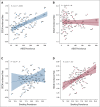State Variation in Squamous Cell Carcinoma of the Anus Incidence and Mortality, and Association With HIV/AIDS and Smoking in the United States
- PMID: 36441987
- PMCID: PMC9937095
- DOI: 10.1200/JCO.22.01390
State Variation in Squamous Cell Carcinoma of the Anus Incidence and Mortality, and Association With HIV/AIDS and Smoking in the United States
Abstract
Purpose: Squamous cell carcinoma of the anus (SCCA) incidence and mortality rates are rising in the United States. Understanding state-level incidence and mortality patterns and associations with smoking and AIDS prevalence (key risk factors) could help unravel disparities and provide etiologic clues.
Methods: Using the US Cancer Statistics and the National Center for Health Statistics data sets, we estimated state-level SCCA incidence and mortality rates. Rate ratios (RRs) were calculated to compare incidence and mortality in 2014-2018 versus 2001-2005. The correlations between SCCA incidence with current smoking (from the Behavioral Risk Factor Surveillance System) and AIDS (from the HIV Surveillance system) prevalence were evaluated using Spearman's rank correlation coefficient.
Results: Nationally, SCCA incidence and mortality rates (per 100,000) increased among men (incidence, 2.29-3.36, mortality, 0.46-0.74) and women (incidence, 3.88-6.30, mortality, 0.65-1.02) age ≥ 50 years, but decreased among men age < 50 years and were stable among similar-aged women. In state-level analysis, a marked increase in incidence (≥ 1.5-fold for men and ≥ two-fold for women) and mortality (≥ two-fold) for persons age ≥ 50 years was largely concentrated in the Midwestern and Southeastern states. State-level SCCA incidence rates in recent years (2014-2018) among men were correlated (r = 0.47, P < .001) with state-level AIDS prevalence patterns. For women, a correlation was observed between state-level SCCA incidence rates and smoking prevalence (r = 0.49, P < .001).
Conclusion: During 2001-2005 to 2014-2018, SCCA incidence and mortality nearly doubled among men and women age ≥ 50 years living in Midwest and Southeast. State variation in AIDS and smoking patterns may explain variation in SCCA incidence. Improved and targeted prevention is needed to combat the rise in SCCA incidence and mitigate magnifying geographic disparities.
Figures






Comment in
-
Trends in Anal Cancer: Leveraging Public Health Efforts to Improve Cancer Care.J Clin Oncol. 2023 Feb 20;41(6):1180-1182. doi: 10.1200/JCO.22.02584. Epub 2023 Jan 12. J Clin Oncol. 2023. PMID: 36634301 No abstract available.
References
-
- Vespa J, Armstrong DM, Medina L: Demographic Turning Points for the United States: Population Projections for 2020 to 2060: Population Estimates and Projections. Department of Commerce Economics and Statistics Administration, Washington, DC, US Census Bureau, 2018, pp 25-1144
Publication types
MeSH terms
Grants and funding
LinkOut - more resources
Full Text Sources
Medical
Research Materials

